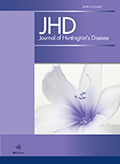Authors: Waddell, Emma M. | Dinesh, Karthik | Spear, Kelsey L. | Elson, Molly J. | Wagner, Ellen | Curtis, Michael J. | Mitten, David J. | Tarolli, Christopher G. | Sharma, Gaurav | Dorsey, E. Ray | Adams, Jamie L.
Article Type:
Research Article
Abstract:
Background: Current Huntington’s disease (HD) measures are limited to subjective, episodic assessments conducted in clinic. Smartphones can enable the collection of objective, real-world data but their use has not been extensively evaluated in HD. Objective: Develop and evaluate a smartphone application to assess feasibility of use and key features of HD in clinic and at home. Methods: We developed GEORGE® , an Android smartphone application for HD which assesses voice, chorea, balance, gait, and finger tapping speed. We then conducted an observational pilot study of individuals with manifest HD, prodromal HD, and without a movement disorder.
…In clinic, participants performed standard clinical assessments and a battery of active tasks in GEORGE. At home, participants were instructed to complete the activities thrice daily for one month. Sensor data were used to measure chorea, tap rate, and step count. Audio data was not analyzed. Results: Twenty-three participants (8 manifest HD, 5 prodromal HD, 10 controls) enrolled, and all but one completed the study. On average, participants used the application 2.1 times daily. We observed a significant difference in chorea score (HD: 19.5; prodromal HD: 4.5, p = 0.007; controls: 4.3, p = 0.001) and tap rate (HD: 2.5 taps/s; prodromal HD: 8.9 taps/s, p = 0.001; controls: 8.1 taps/s, p = 0.001) between individuals with and without manifest HD. Tap rate correlated strongly with the traditional UHDRS finger tapping score (left hand: r = –0.82, p = 0.022; right hand: r = –0.79, p = 0.03). Conclusion: GEORGE is an acceptable and effective tool to differentiate individuals with and without manifest HD and measure key disease features. Refinement of the application’s interface and activities will improve its usability and sensitivity and, ideally, make it useful for clinical care and research.
Show more
Keywords: Huntington’s disease, chorea, motor function, gait, smartphone, technology
DOI: 10.3233/JHD-200452
Citation: Journal of Huntington's Disease,
vol. 10, no. 2, pp. 293-301, 2021
Price: EUR 27.50




